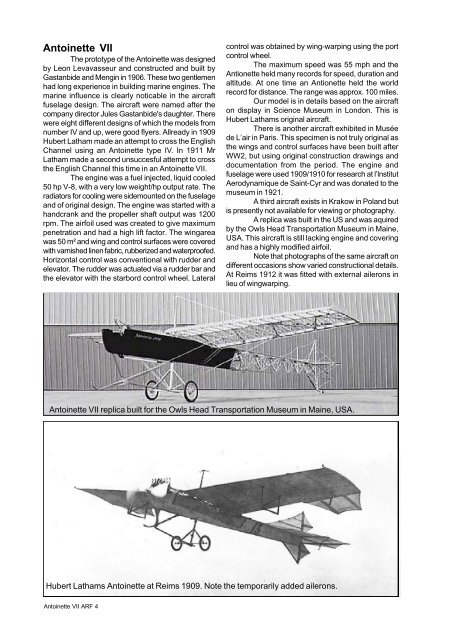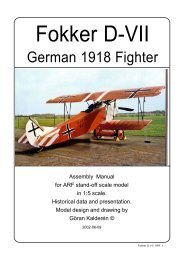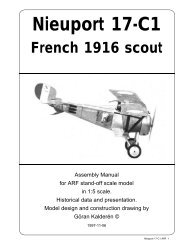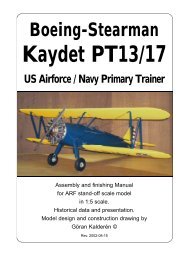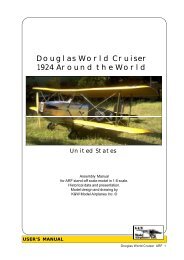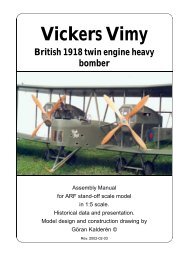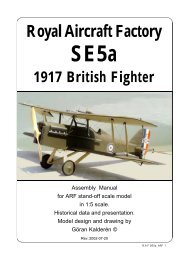Download PDF Manual - Macca's Vintage Aerodrome
Download PDF Manual - Macca's Vintage Aerodrome
Download PDF Manual - Macca's Vintage Aerodrome
Create successful ePaper yourself
Turn your PDF publications into a flip-book with our unique Google optimized e-Paper software.
Antoinette VII<br />
The prototype of the Antoinette was designed<br />
by Leon Levavasseur and constructed and built by<br />
Gastanbide and Mengin in 1906. These two gentlemen<br />
had long experience in building marine engines. The<br />
marine influence is clearly noticable in the aircraft<br />
fuselage design. The aircraft were named after the<br />
company director Jules Gastanbide's daughter. There<br />
were eight different designs of which the models from<br />
number IV and up, were good flyers. Allready in 1909<br />
Hubert Latham made an attempt to cross the English<br />
Channel using an Antoinette type IV. In 1911 Mr<br />
Latham made a second unsuccesful attempt to cross<br />
the English Channel this time in an Antoinette VII.<br />
The engine was a fuel injected, liquid cooled<br />
50 hp V-8, with a very low weight/hp output rate. The<br />
radiators for cooling were sidemounted on the fuselage<br />
and of original design. The engine was started with a<br />
handcrank and the propeller shaft output was 1200<br />
rpm. The airfoil used was created to give maximum<br />
penetration and had a high lift factor. The wingarea<br />
was 50 m² and wing and control surfaces were covered<br />
with varnished linen fabric, rubberized and waterproofed.<br />
Horizontal control was conventional with rudder and<br />
elevator. The rudder was actuated via a rudder bar and<br />
the elevator with the starbord control wheel. Lateral<br />
control was obtained by wing-warping using the port<br />
control wheel.<br />
The maximum speed was 55 mph and the<br />
Antionette held many records for speed, duration and<br />
altitude. At one time an Antionette held the world<br />
record for distance. The range was approx. 100 miles.<br />
Our model is in details based on the aircraft<br />
on display in Science Museum in London. This is<br />
Hubert Lathams original aircraft.<br />
There is another aircraft exhibited in Musée<br />
de L’air in Paris. This specimen is not truly original as<br />
the wings and control surfaces have been built after<br />
WW2, but using original construction drawings and<br />
documentation from the period. The engine and<br />
fuselage were used 1909/1910 for research at l’lnstitut<br />
Aerodynamique de Saint-Cyr and was donated to the<br />
museum in 1921.<br />
A third aircraft exists in Krakow in Poland but<br />
is presently not available for viewing or photography.<br />
A replica was built in the US and was aquired<br />
by the Owls Head Transportation Museum in Maine,<br />
USA. This aircraft is still lacking engine and covering<br />
and has a highly modified airfoil.<br />
Note that photographs of the same aircraft on<br />
different occasions show varied constructional details.<br />
At Reims 1912 it was fitted with external ailerons in<br />
lieu of wingwarping.<br />
Antoinette VII replica built for the Owls Head Transportation Museum in Maine, USA.<br />
Hubert Lathams Antoinette at Reims 1909. Note the temporarily added ailerons.<br />
Antoinette VII ARF 4


